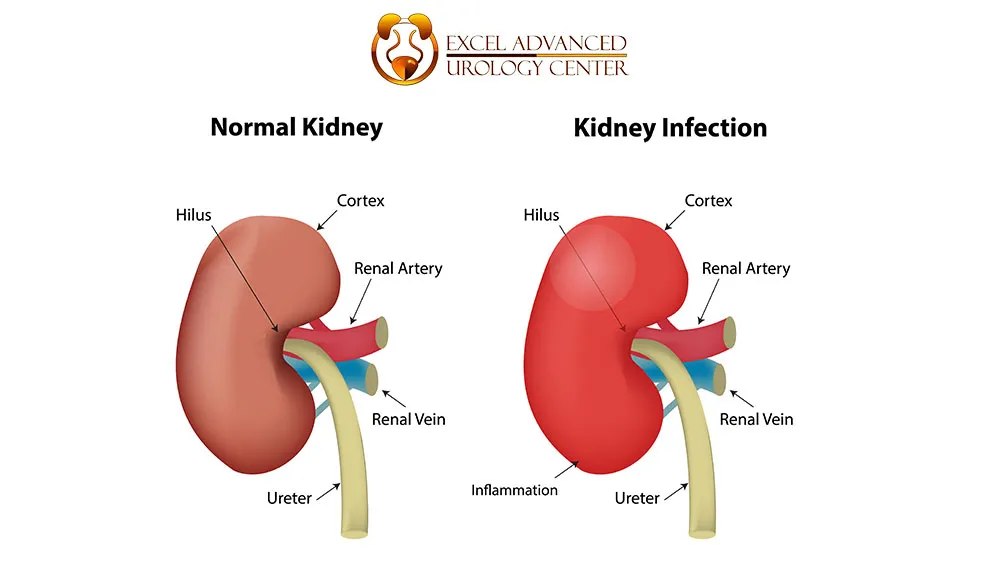Why Excel Advanced Urology Centre is the best option for PCNL
Excel Advanced Urology Centre has a specialized team led by senior urologist Dr Ashish Saini who has performed numerous PCNL surgeries that significantly enhance the success rates and safety of the procedure.What is PCNL?

PCNL stands for Percutaneous Nephrolithotomy. It is a minimally invasive surgical procedure used to remove kidney stones that are too large to pass through the urinary tract or are causing other complications. The procedure involves making a small incision in the patient’s back to access the kidney, and then a nephroscope (a tube with a camera) is inserted to locate and remove the stones. This procedure is often considered when other non-invasive methods, such as shock wave lithotripsy or ureteroscopy, are not suitable for treating kidney stones. PCNL is generally effective in treating large and complex kidney stones, and it can help patients avoid more invasive open surgery.
Explore cutting-edge solutions for pcnl at the renowned Excel Advanced Urology Centre in Delhi
Take the first step towards better health by scheduling a consultation below Schedule ConsultationExplore cutting-edge solutions for pcnl at the renowned Excel Advanced Urology Centre in Delhi
Take the first step towards better health by scheduling a consultation below Schedule ConsultationProcedure
- Initial Examination Before the procedure, the patient undergoes a thorough preoperative evaluation, including medical history, physical examination, blood tests, and imaging studies (such as CT scans or intravenous pyelogram) to assess the size and location of the kidney stones.
- Day of the Procedure
- Anesthesia:The patient is placed under general anesthesia to ensure they are unconscious and pain-free during the procedure.
- Positioning: The patient is positioned on their stomach or side, exposing the kidney to be treated.
- Insertion of Needle:The surgeon makes a small incision in the skin to access the kidney. A needle is then inserted through the skin and into the kidney, guided by fluoroscopy or ultrasound.
- Dilation of Tract: A guide wire is threaded through the needle, and the tract is dilated using a series of dilators to create a pathway to the kidney.
- Insertion of Nephroscope: Once the tract is dilated, a nephroscope (a thin, tube-like instrument with a light and camera) is passed through the tract and into the kidney. The nephroscope allows the surgeon to visualize the stones.
- Stone Fragmentation or Removal: The surgeon may use various tools to break up the kidney stones into smaller pieces. These tools can include ultrasonic or laser devices. In some cases, large stones may be removed intact.
- Stone Retrieval: The broken or fragmented stones are either suctioned out or grasped and removed using forceps or a basket device.
- Placement of a Drain: After stone removal, a tube (nephrostomy tube) may be placed through the tract to drain urine and any residual stone fragments. This tube is typically connected to a drainage bag.
- Closure of Incision: The skin incision is closed with stitches, and a sterile dressing is applied.
- Will I be Awake during the procedure? No, since procedure is done under general anesthesia, you will be unconscious for whole duration of the surgery.
- After the Procedure The patient is monitored in a recovery area before being transferred to a regular hospital room. Pain management and recovery care are provided.

Advantages of PCNL
Percutaneous Nephrolithotomy (PCNL) has several advantages as a treatment option for kidney stones, especially when compared to more traditional open surgical approaches. Some of the advantages include:- Minimally Invasive: PCNL is a minimally invasive procedure, meaning it requires only small incisions rather than a large surgical opening. This typically leads to shorter recovery times and less postoperative pain.
- High Stone Clearance Rates: PCNL is effective in removing large and complex kidney stones. The procedure allows for direct access to the kidney, making it easier for the surgeon to visualize and remove stones.
- Reduced Hospital Stay: Due to its minimally invasive nature and efficient stone removal capabilities, PCNL often results in shorter hospital stays compared to traditional open surgery.
- Quick Recovery: Patients undergoing PCNL typically experience a faster recovery compared to open surgery. Many patients can resume normal activities within a relatively short period after the procedure.
- Lower Morbidity: PCNL generally has lower complication rates compared to open surgical procedures for kidney stones. The risk of infection is minimized due to the use of small incisions.
- Versatility: PCNL can be used for a wide range of stone sizes and locations within the kidney. It is particularly suitable for large stones, staghorn calculi, or stones in complex anatomical situations.
- Improved Stone Visualization: The use of a nephroscope with a camera allows for clear visualization of the stones and the surrounding structures, enabling the surgeon to precisely target and remove the stones.
- Reduced Need for Additional Procedures: In some cases, PCNL may reduce the need for additional stone removal procedures, as it can effectively clear the stones in a single session.
Side effects of PCNL
While Percutaneous Nephrolithotomy (PCNL) is generally a safe and effective procedure for the removal of kidney stones, like any medical intervention, it carries some potential risks and side effects. It’s important to note that the likelihood and severity of these side effects can vary from patient to patient. Some possible side effects and complications of PCNL may include:- Bleeding: Bleeding is a common side effect of PCNL. Most cases are mild and resolve on their own, but excessive bleeding may require further intervention.
- Infection: There is a risk of infection associated with any surgical procedure. In PCNL, the risk is generally low, but if it occurs, it may require antibiotics or additional treatment.
- Pain: Patients may experience pain or discomfort at the incision site or in the kidney region. This is usually managed with pain medication.
- Scarring: While PCNL is minimally invasive, it still involves making incisions, which can result in scarring. The scars are generally small and heal over time.
- Pleural Effusion: Fluid accumulation around the lungs (pleural effusion) is a potential complication, but it is relatively rare.
- Damage to Surrounding Structures: There is a small risk of injury to nearby structures such as blood vessels or the bowel during the procedure. This risk is minimized by careful planning and the use of imaging techniques.
- Incomplete Stone Removal: In some cases, it may not be possible to completely remove all stones during the initial PCNL, requiring additional procedures.
- Residual Fragments: Small stone fragments may be left behind after the procedure, which may require additional interventions or monitoring.
- Complications from Anesthesia: As with any surgical procedure, there is a risk of complications related to anesthesia.
Is PCNL Safe
The safety of PCNL depends on various factors, including the patient’s overall health, the size and location of the kidney stones, the surgeon’s expertise, and the availability of appropriate medical facilities. Here are some key points regarding the safety of PCNL:- Experienced Surgeons: The skill and experience of the surgeon performing the PCNL procedure significantly influence its safety and success. Surgeons who specialize in urology and have expertise in minimally invasive procedures tend to have better outcomes.
- Patient Selection: Careful patient selection is crucial. PCNL is often recommended for larger or complex kidney stones that may not be effectively treated with less invasive methods. However, not all patients or stones are suitable candidates for PCNL.
- Preoperative Evaluation: Thorough preoperative assessment, including imaging studies, helps identify potential anatomical variations and reduce the risk of complications during the procedure.
- Facility and Equipment: Performing PCNL in a well-equipped medical facility with appropriate imaging technology and supportive staff enhances the safety of the procedure.
- Postoperative Care: Adequate postoperative care and monitoring are essential to identify and address any complications promptly. This includes managing pain, monitoring for bleeding or infection, and ensuring proper healing.
Explore cutting-edge solutions for pcnl at the renowned Excel Advanced Urology Centre in Delhi
Take the first step towards better health by scheduling a consultation below Schedule Consultation
When PCNL is needed?
Here are common scenarios in which PCNL may be considered necessary:- Large Stones: PCNL is often recommended for the removal of large kidney stones, typically those greater than 2 cm in size. These stones may be challenging to pass naturally or may cause obstruction and symptoms.
- Staghorn Calculi: Staghorn calculi are stones that form in the renal pelvis and branch out into multiple calyces of the kidney. These complex stones can often be effectively treated with PCNL.
- Failure of Conservative Management: When other treatment options, such as lifestyle modifications, medications, or dietary changes, fail to manage symptoms or reduce the size of the stones adequately, PCNL may be considered.
- Symptomatic Stones: If kidney stones cause severe pain, recurrent urinary tract infections (UTIs), or impaired kidney function, and conservative measures are insufficient, PCNL may be recommended to alleviate symptoms and improve kidney function.
- Anatomical Considerations: The anatomy of the urinary tract can influence the choice of treatment. PCNL is often considered when there are anatomical factors that make other approaches, such as shock wave lithotripsy or ureteroscopy, less effective.
- Complications from Stones: Stones that lead to complications, such as recurrent urinary tract infections, hydronephrosis (swelling of the kidney), or bleeding, may warrant the use of PCNL for prompt and effective removal.
- Presence of Hard or Resistant Stones: Certain types of kidney stones, such as cystine or struvite stones, may be particularly hard or resistant to fragmentation with other methods. PCNL can be effective in breaking down and removing these types of stones.
What would disqualify me from PCNL Surgery?
Not every patient is a suitable candidate for Percutaneous Nephrolithotomy (PCNL). Several factors may disqualify an individual from undergoing PCNL surgery. Some common reasons include:- Medical Conditions: Certain medical conditions may increase the risk of complications during or after surgery. For example, individuals with bleeding disorders, severe cardiovascular issues, or uncontrolled infections may be considered poor candidates for PCNL.
- Severe Renal Dysfunction: If a patient has severely impaired kidney function, PCNL may not be the preferred option. The procedure involves temporarily blocking the drainage of urine from the kidney, and in individuals with compromised kidney function, this can pose additional risks.
- Unsuitable Anatomy: Anatomical variations or abnormalities in the urinary tract may make it challenging to perform PCNL safely and effectively. The surgeon needs a clear path to access the kidney, and certain anatomical configurations may limit this.
- Pregnancy: PCNL is generally not performed on pregnant individuals due to potential risks to the fetus. If kidney stones need to be addressed during pregnancy, alternative, less invasive treatments may be considered.
- Active Infection: If a patient has an active urinary tract infection (UTI) or another systemic infection, the procedure may be postponed until the infection is adequately treated. Performing PCNL in the presence of infection increases the risk of complications.
- Unrealistic Expectations: If a patient has unrealistic expectations regarding the outcome of the surgery or is not willing to comply with postoperative care and follow-up, healthcare providers may reconsider PCNL.
- Patient Preference or Contraindications: In some cases, a patient’s preferences or contraindications to anesthesia may influence the choice of treatment. PCNL requires anesthesia, and certain individuals may not be suitable candidates for this type of sedation.
How much PCNL cost in Delhi?
The cost of PCNL surgery is determined by various factors. However this treatment is reasonable and easily accessible to the general public. The cost of PCNL surgery in India may vary from Rs. 70,000 to 90,000 depending on the characteristics of the amount/size of stones, etc.Why choose Excel Advanced Urology Centre for PCNL Surgery?
Excel Advanced Urology Centre has a specialized team led by senior urologist Dr Ashish Saini who has performed numerous PCNL surgeries that significantly enhance the success rates and safety of the procedure.

